Château Rauzan-Gassies
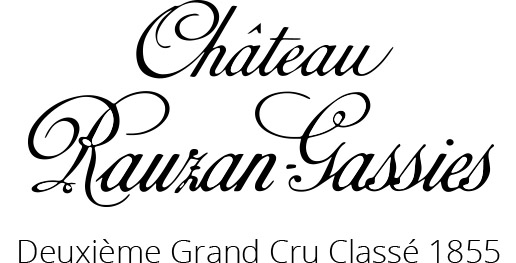
The Estate
The origins of the noble house of Gassies in the Médoc go back to medieval times. The Lords of Gassies were considered knights, and owed allegiance to the owners of Château Margaux. Monsieur de Rauzan acquired the seigneury in 1661 and is responsible for establishing the reputation of its wine. The estate was divided into two parts in 1785. The name of one of these, Rauzan-Gassies, very much reflects its historic roots.
Since 1946, second growth Château Rauzan-Gassies has belonged to the Quié family, who also own Châteaux Croizet- Bages (a great growth of Pauillac) and Bel Orme Tronquoy de Lalande.
Monsieur Paul Quié undertook a major renovation of the vineyard during the postwar period. This was finalized by his son, Jean-Michel, who took over management in 1968. He is assisted by his children, Anne-Françoise and Jean-Philippe, in overseeing the three family châteaux. Their passion for fine wine is very much in the tradition of the great growths of Bordeaux, and one of Jean-Michel Quié’s greatest pleasures is to share his wine with people who are dear to him.

Château Rauzan-Gassies Margaux 2ème Grand Cru Classé
Production Area: 28.5 hectares
Climate: Château Rauzan Gassies shares a similar climate to that enjoyed by the Médoc: maritime, with the Gironde estuary & the Bay of Biscay combining to act as a climate regulator & the coastal pine forests sheltering the vines from the westerly & north-westerly winds.
Soil: Deep gravel and sand
Average Age of the Vines: 35 years old
Plant Density: 10,000 vines/hectare
Average Yield: 40 hl/ha
Grape Varieties: Cabernet Sauvignon, Merlot, Petit Verdot
Training Method: Poussard
Viticulture: Mechanical working of the soil or use of grass between vine rows. Removal of the laterals and manual repositioning of the clusters. Thinning out of the leaves before the harvest.
Harvest: Manual
Vinification: Stainless steel vats from 12-120 hl to optimize the plot by plot selection. Fermentations is carried out at temperatures of 26-28ºC. 2-3 pumpings-over per day. Malolactic fermentation in barrels and stainless-steel vats.
Aging: 12 months in French oak barrels
Production: Around 70,000 bottles

L'Orme de Rauzan-Gassies
Overview: L’Orme de Rauzan Gassies is made from a vineyard just to the north of Margaux on the terroirs of Saint Seurin de Cadourne. It is neither a second nor third wine, but an entirely separate parcel, skillfully crafted by the wine making team at Rauzan-Gassies.
Terroir: The famous terroir of the Saint Seurin de Cadourne village.
Grape Varieties: 65% Merlot and 35% Cabernet Sauvignon (percentages vary depending on the vintage)
Harvest: Manual harvesting then manual and mechanical sorting.
Vinification: Alcoholic fermentation lasts 6-8 days. Malolactic fermentation for 15-30 days. Merlot vatting time is 17-21 days, with 19-22 days for the Cabernet Sauvignon.
Aging: 12 months in French oak barrels.
Yield: 50 hl/ha
Tasting Notes: Deep, lovely ruby color. An expressive nose with notes of violet, sandalwood, and dark fruit, lively and intense. On the palate, it is fresh and silky with very pure, ripe, and rounded fruit flavors. The classic Margaux balance between delicate, perfumed aromas and opulent fruit and spice notes makes for an immensely satisfying and complex wine.
Alcohol: 13%

Les Ailes de Rauzan-Gassies Margaux
Overview: Created 20 years ago, Les Ailes de Rauzan-Gassies is the result of a short collaboration with Maison Dubos Negociants. Les Ailes de Rauzan-Gassies, mainly produced with the young vines, pays tribute with its name to this historical terroir. Vinified and aged with the same care and attention as the First Wine, Les Ailes de Rauzan-Gassies has a delicious ripe, delicate fruity flavor, and velvety tannins.
Owner: The Quié family
Consulting Oenologist: Eric Boissenot
Production Area: 28 hectares
Appellation: Margaux
Soil: Deep, sandy gravels
Average Age of the Vines: 35 years
Plant Density: 10,000 plants per hectare
Average Yield: 40 hl/ha
Grape Varieties: 58% Cabernet Sauvignon, 40% Merlot, 2% Petit Verdot
Viticulture: Mechanical work of the soil or use of grass between-rows. Poussard pruning. Removal of the laterals and manual repositioning of the clusters. Thinning out of the leaves before the harvest.
Vinification: Stainless steel vats from 12-120 hl to optimize the plot by plot selection. Fermentations: temperatures from 26-28ºC; 2 to 3 pumpings-over a day. Malolactic fermentations in barrels and stainless steel vats.
Aging: 12 months in French oak barrels. Traditional racking. Fining with egg whites.
Château Rauzan-Ségla
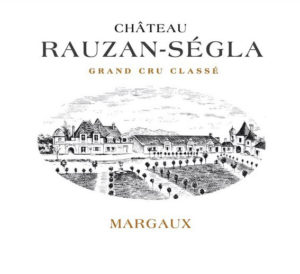
The Estate
The history of Chateau Rauzan-Segla can be traced all the way back to 1661. Around that time, Pierre Desmezures de Rauzan, a man very much immersed in the Bordeaux wine trade, took ownership of the Noble House of Gassies. He was at different times the manager of Chateau Margaux and Chateau Latour, and he also acquired lands that would eventually become Pichon Lalande and Pichon Baron in Pauillac.
Rauzan-Segla’s fame for producing high quality wines grew in the 18th century. Thomas Jefferson famously ordered 10cs of wine after visiting the estate, declaring it to be in the top tier of the Second Growths.
Ownership of Rauzan Segla has passed through many hands, including that of the Cruse family, the Melson family, British shipping company John Holt Ltd, and eventually landing with the owners of Chanel, the Wertheimer brothers, in 1994. The brothers undertook a full renovation of the estate in the 90s.
Since 2012, the estate has begun to produce wines in a more organic fashion. In fact, a portion of the vineyard is now devoted to farming with Shire horses.

Château Rauzan-Ségla Margaux 2ème Grand Cru Classé
Production Area: 70 hectares
Soil: Clay-gravel soils from Terrace 4, fine sandy-clay gravel soil, sandy-clay soils
Plant Density: 6,666 to 10,000 plants/ha
Average Age of the Vines: 37 years
Grape Varieties: 61% Cabernet Sauvignon, 37% Merlot, 1% Petit Verdot, 1% Cabernet Franc (percentages vary depending on the vintage)
Harvest: By separate parcel and intra-parcel, by hand, in small crates
Sorting: Manual selection
Vinification: Separate parcel and intra-parcel vinification, with vatting via gravity, in temperature-controlled stainless steel vats.
Aging: In French oak barrel, with a medium and medium-long toasting. Racking via the bunghole. Fining with egg whites in barrel.
Alcohol: 14%
2001 Reviews: “A huge, powerful, dense wine, which layers pure black fruits over dusty tannins. This is an impressive wine, proof of Rauzan-Ségla’s improvements since Chanel took over ownership. It is packed with fruits, like an intense jelly, but also has dryness, acidity and good aging potential.”-94pts, Wine Enthusiast
Château Réal
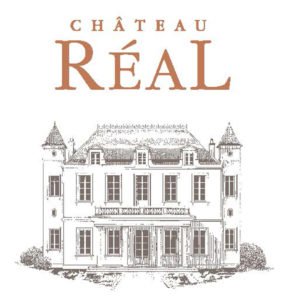
The Estate
Château Réal is operated by the owner of Château Serilhan, Didier Marcelis. It is the last chateau belonging to the Tronquoy family, former owner of Châteaux Montrose and Tronquoy Lalande. The wine is vinified by Hubert De Boüard, current owner of Château Angélus. Following the renovation of the cellars, this property became eligible for the Cru Bourgeois for the 2010 vintage.

Château Réal Haut-Médoc
Appellation: Haut-Médoc
Production Area: 6 hectares, all in Haut-Médoc, around the cities of St Seurin de Cadourne and Cissac-Medoc
Soil: Gunzian gravel, clay, and limestone
Average Age of the Vines: 35 years old
Grape Varieties: 57% Cabernet Sauvignon, 35% Merlot, 8% Cabernet Franc
Viticulture: Cover crop, ploughing, crop-thinning, and leaf-thinning
Harvest: Manual
Vinification: Sorting table. Steel tanks. Vatting for 25 to 30 days. Cold maceration for 4 days. Pneumatic pressing.
Aging: 18 months in barrel
Annual Production: 20,000 bottles
Alcohol: 14%
Château Rieussec
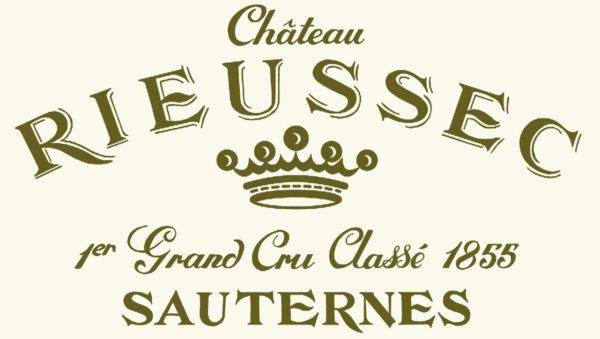
History
For the 1855 classification, M. Mayne was the owner of the estate. The quality of the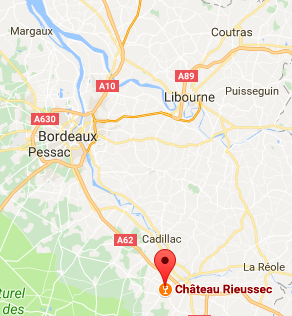 Rieussec soil earned its ranking as a first growth Sauternes and Barsac. After that date, Rieussec’s history involves many changes of owners: Charles Crepin (around 1870), Paul Defolie (1892), Mr. Bannil (1907), then the Gasqueton family (owner of Château Calon-Ségur at Saint Estèphe), P.F. Berry during the war (an American citizen and brother-in-law of the Vicomte de Bouzet), Mr. Balaresque (1957) and lastly, Albert Vuillier (1971), who was passionate about Sauternes’ “sweet wines”.
Rieussec soil earned its ranking as a first growth Sauternes and Barsac. After that date, Rieussec’s history involves many changes of owners: Charles Crepin (around 1870), Paul Defolie (1892), Mr. Bannil (1907), then the Gasqueton family (owner of Château Calon-Ségur at Saint Estèphe), P.F. Berry during the war (an American citizen and brother-in-law of the Vicomte de Bouzet), Mr. Balaresque (1957) and lastly, Albert Vuillier (1971), who was passionate about Sauternes’ “sweet wines”.
Château Rieussec was acquired by Domaines Barons de Rothschild (Lafite) in 1984. The estate then consisted of 110 hectares, 68 hectares of which were vines. To enhance Château Rieussec’s potential, rigorous measures were implemented, including meticulous sorting of the grapes and fermenting in barrels, which provides a much finer selection for the blending of the Grand Vin.
A new cellar was built in 1989 to extend the ageing period in barrels. The quantities of the Grand Vin that were produced were much reduced in the 1990’s due to more meticulous selection, to the point that none at all was produced in 1993 (this was also the case in 1977 and again in 2012).
In 2000, the renovation of the maturing cellar, the construction of a fermentation room, and the modernisation of the reception and pressing areas also represented strides forward in a quality policy that was launched in 1985.
The first attempts at selection were rewarded by a remarkable trio of vintages in 1988, 1989 and 1990. This was crowned by an entire decade of very good wines from 1995 to 2005. The weather proved to be no obstacle for the remarkable vintages of 1996, 1997, 1999, 2001, 2003 and 2005, among others! Furthermore, Château Rieussec 2001 was declared Wine of the Year in 2004 by Wine Spectator magazine.
The Terroir
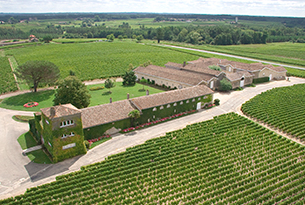 The Château Rieussec vineyard extends to the border of Fargues and Sauternes, and adjoins Château d’Yquem. Rieussec is one of the largest properties in Sauternes and Barsac, the vineyard covers 93 hectares of gravelly sandy-clay soil.
The Château Rieussec vineyard extends to the border of Fargues and Sauternes, and adjoins Château d’Yquem. Rieussec is one of the largest properties in Sauternes and Barsac, the vineyard covers 93 hectares of gravelly sandy-clay soil.
The iconic grape variety of Sauternes, Sémillon, dominates (90%), followed by Sauvignon (7%) and Muscadelle (3%). Traditional Sauternes techniques are used and the harvests are carried out with selective pickings depending on the ripeness of the grapes and evolution of botrytis cinerea (noble rot). They last for 6 to 8 weeks from September to November.
Production is low and firmly in the hands on Mother Nature. The traditional saying is that a single vine should produce a bottle of wine. Here, though, a single vine produces about a glass of wine!
The vineyard is managed by Eric Kohler, Technical Director of the Bordeaux Châteaux, with the help of Jean de Roquefeuil, Vineyard Manager, and Serge Lagardère, Cellar Master.
Vinification
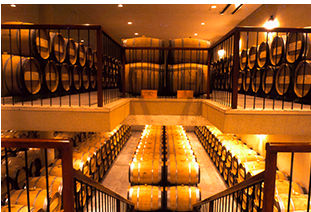 Wines are fermented in barrels. The yields are sorted and each parcel is identified and isolated in a batch of barrels, in order to judge whether or not it can be used in the Grand Vin after fermentation. Several tastings from each barrel are then performed in order to ensure a rigorous selection for the Grand Vin.
Wines are fermented in barrels. The yields are sorted and each parcel is identified and isolated in a batch of barrels, in order to judge whether or not it can be used in the Grand Vin after fermentation. Several tastings from each barrel are then performed in order to ensure a rigorous selection for the Grand Vin.
The cellars are located in the heart of the Château Rieussec vineyard at Fargues. Each vintage ages in oak barrels produced mostly at DBR’s cooperage. Half of them are renewed every year. The length of ageing in barrels varies from 16 to 26 months, during which the wines are periodically racked. The wines are bottled at the Château.
Production at Château Rieussec and Carmes de Rieussec varies a great deal depending on the vintage, but on average it is 12,000 cases per year. Rieussec also produces small quantities of a dry white wine, “R” de Rieussec.

Sauternes 1er Cru Classé
Overview: Château Rieussec has been a leading wine in Sauternes for several generations. Ranked as a Premier Grand Cru in 1855, it is made with a subtle blend of Sémillon, Sauvignon and Muscadelle.
Varietal Blend: 90 to 95% Sémillon, 5% to 10% Muscadelle and Sauvignon (87% Semillon, 8.5% Sauvignon, 4.5% Muscadelle for the 2007 vintage)
Aging: in oak barrels for 18 to 26 months depending on the year, 50 to 55% in new barrels.
Annual Production: 6,000 cases
Tasting Notes: Very bright, golden color. Very candied nose with delicious notes of figs and apricots. Rich, full-bodied palate with intense notes of candied fruit and excellent length.

Les Carmes de Château Rieussec Sauternes
Overview: Château Rieussec’s second wine is selected according to the same standards as the first wine. Its character consistently reveals a beautiful aromatic range dominated by citrus flavours. Carmes de Rieussec’s name is a reference to the Carmelite monks in Langon, who owned the Rieussec estate in the 18th century.
Varietal Blend: 80-90% Sémillon; 10-20% Sauvignon and Muscadelle
Aging: In oak barrels for 18 months
Annual Production: 6,000 cases
Tasting Notes: Initially presenting Sauvignon aromas, the nose is then dominated by freshness and exotic notes. On the palate the attack is clean, direct, and silky, followed by slightly spicy notes of honey that extend into a lively finish. An aperitif wine best enjoyed young and thoroughly chilled.
Serving Suggestion: Decant just before enjoying at a temperature of about 8 -10°C

R de Rieussec Bordeaux Blanc Sec
Appellation: AOC Bordeaux. The Sauternes appellation stretches on the left bank of the Garonne, about 50km South of Bordeaux. The natural humidity arising from the Ciron river provides the ideal conditions for the development of Bortrytis Cinerea, also known as noble rot.
Terroir: Château Rieussec sits on the border of Fargues and Sauternes, bordered by Château d’Yquem to the West. Rieussec is one of the largest properties in Sauternes and Barsac, covering 85 hectares of gravel sitting on sandy-clay soils.
Viticulture: In conversion to organic farming
Harvest: The grapes are harvested by hand into small crates on the plots selected for R de Rieussec. The Sauvignon is picked fairly early to preserve its freshness and rich thiol aromas, while the Sémillon is harvested when the grapes are thoroughly ripe to give the wine structure and body. The harvest is refrigerated before pressing to reduce oxidation.
Vinification: Pressing is gentle so as to preserve the grapes’ aromatic freshness. After cold settling, a large part of the Sémillon musts is vinified in new oak barrels and barrels that have held one wine. The Sauvignon musts are mainly vinified in stainless steel tanks at low temperature and a smaller quantity in barrels that have held one wine.
Aging: At the end of the fermentation process, the wines in barrels are aged on the lees for six months with regular stirring. After aging, the wines in stainless steel vats (50%) and in barrels (50%) are blended prior to bottling.
Château Rouget
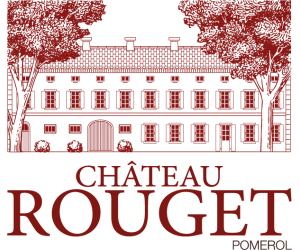
The Estate
Château Rouget history began several centuries ago. Already in existence at the end of the Roman Empire, Château Rouget’s terroirs were at that time merged with those of St Emilion.
Château Rouget appears in archives and the land register from 1700 onwards, and is considered one of the first official Pomerol Crus. This period corresponds to the building date of the splendid house symbolizing the estate, belonging then to the Bayonne family. The last family member involved in the estate, Pierre Bayonne, was also mayor of Pomerol during the First Empire. As a talented winemaker, he used Chateau Rouget as a perfect display for his skills.
At the end of the 19th century, a classification of Pomerol wines placed Rouget among the top five estates of the appellation. This recognition stems from the remarkable constancy showed by consecutive owners of the estate, who all worked hard to produce iconic wines. The Labruyère Family, who has owned Rouget since 1992, follows the same path. For more than 20 years, they have put all of their efforts behind positioning Château Rouget among Right Bank leaders.
The estate is now considered by critics and amateurs as the winery which has made the most consistent progress across the appellation, vintage after vintage.
The Team
The Labruyère family comes from Beaujolais region, where they have owned a winery in the Moulin-à-Vent appellation since 1850. Over the years, they chose to become established in other French major wine regions, using terroir quality criterion. This is how they selected Château Rouget in 1992. As head of the family, Jean-Pierre Labruyère had the ambition to restore the former glory of this property which had been recognized from 1868 as one of the best producers in Pomerol. In 2008, he passed management of the estate to his son Edouard who, with the help of estate manager Antoine Ribeiro and his team, carries on this hard work with the same ardor and passion.
The Vineyard
The Pomerol plateau is located near Libourne, northeast of Bordeaux. It slopes down across various terraces towards the Isle valley, a tributary of the Dordogne River. Thanks to the quality of its terroirs and wines, Pomerol is one of the most sought after appellations in the world. In Pomerol, Merlot is king. Clayey soils allow this grape to express itself like nowhere else worldwide. Located near Eglise-Clinet, Petrus and Le Gay, Château Rouget, which encompasses 17 hectares today, stretches across the gentle slopes of the Pomerol plateau near the village and the old church. Two thirds of vines are located around the estate, but Château Rouget also includes beautiful plots facing Petit Village, Le Pin, and Trotanoy. Vineyards are planted with the most suited grape varietals: Merlot represents 85% and is combined with Cabernet Franc. Soils can be either composed of clay and gravel, or clay and silica. Subsoils consist of iron-rich sandstone. The vines are around 40 years old. The vast replanting program started in 1992 combined with the purchase of 2 high-quality hectares from the prestigious neighboring estates on the high plateau in 1999 have considerably reinforced the position of the cru.
Vinification
In 2001, the cellar was entirely restored by the Labruyère Family with the idea of implementing a vineyard designated approach. Old vats have been replaced by truncated oak vats of 50 and 60 hl. They combine ancestral handicraft with state-of-the-art technology. A few stainless steel tanks have also been incorporated. The whole installation is thermo-regulated.
Maturity is a key concern at Chateau Rouget. Thus, the harvest date is carefully chosen in order to pick up the most balanced fruits. Harvest occurs in several passages in order to ensure an optimal maturity level. The grapes are handpicked and transported in small crates in order to prevent them from being crushed. With the same concern for quality, bunches are sorted a first time as soon as they reach the cellar. Then, once grapes are fully destemmed, they go through another double sorting table. Only the best grapes are kept for Chateau Rouget’s wines. Grapes are vinified batch by batch in order to render the best expression of each parcel. The benefits of putting wine into barrels as early as possible are widely known. For the past few years, Château Rouget has vinified part of its wine according to that idea: whole destemmed berries are directly poured in barrels after being sorted. Thanks to this method, both the fermentation and aging processes will take place in the barrel. This technique – very respectful of grapes – enables gentle extraction and, eventually, softer tannins.

Le Carillon de Rouget Pomerol
Terroir: The terroirs dedicated to Le Carillon de Rouget are more aerial than the ones selected for Château Rouget. This, combined with the relative youth of the vines, compared to the ones of the Grand Vin, result in earlier ripening and give the wine its roundness and appealing character.
Grape Varieties: 85% Merlot, 15% Cabernet Franc
Planting Density: 7,500 vines/hectare
Average Age of Vines: 20 years
Viticulture: Vineyards are sustainably farmed, using practices such as cover crops and ploughing.
Harvest: Grapes are harvested by hand, in small 20kg crates. Each plot is harvested individually in order to ensure optimal ripeness of the entire crop.
Grapes are then sorted carefully.
Vinification: Grapes from different parcels are vinified separately in stainless steel tanks, then aged in oak barrels (second fill) for 14 months. This vintage was bottled on a fruit day according to the lunar calendar, to allow the wine to express itself fully.
Tasting Notes: Dense ruby color. Expressive notes of ripe red and black fruits on the nose. Generous, rich, and ample on the palate with black fruit notes. Delicate on the finish with embracing and warm tannins.
Cellaring: 10 years
Château Sénéjac

The Estate
The Senejac vineyard stretches over the plateau overlooking the Pian Medoc commune. Nicolas de Bloys was the first owner of this former barony in the 16th century. In 1999, a new incentive emerged to bring the vineyard on par with the best wines of the Médoc with the acquisition of the property by Lorraine Cordier, also owner of Château Talbot, a Grand Cru Classé of Saint Julien. Following her death, her sister, Nancy Bignon-Cordier, and her family now run the estate.

Château Sénéjac Haut-Médoc
Location: Located to the far southern end of the Haut Medoc appellation in the Le Pian Medoc commune. The Left Bank vineyard is in one large block.
Production Area: 39 hectares
Soil: Deep gravel
Grape Varieties: 48% Cabernet Sauvignon, 37% Merlot, 11% Cabernet Franc and 4% Petit Verdot (Percentages vary depending on the vintage)
Average Age of the Vines: 35 years old
Plant Density: 6,600 vines/ha
Yield: 51 hl/ha
Winemaker: Alfred Tesseron, also winemaker of Chateau Pontet Canet
Harvest: Manual and mechanical
Vinification: In 17 thermo-regulated, stainless-steel tanks. Malolactic fermentation takes place in barrel.
Aging: In 33% new, French oak barrels for an average of 12-15 months, depending on the vintage
Average Production: 16,000 cases of wine per year
Tasting Notes: Château Sénéjac has a beautiful red color with bright reflections. The nose is precise with notes of cherry. It continues with spicy notes revealing the expression of the Petit Verdot. The attack on the palate is fresh, balanced and smooth. The tannins are silky and distinctive. On the palate, the fruit is ripe and plump. The finish is long, precise with a beautiful aromatic intensity. It is an elegant, aromatic wine with a beautiful tannic finesse that will delight all Médoc amateurs.
Chateau Siaurac (Biodynamic)
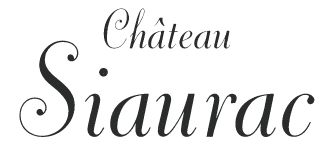
Overview
The estate is located on the plateau of Néac, which is a continuation of the famous plateau of Pomerol, and its vineyard is in a single, contiguous plot. It is the largest estate of the appellation and is comprised of 46 hectares of planted vine, a nineteenth-century château, and 15 hectares of romantic rolling parkland, home to centuries-old trees, an orangery and eighteenth-century landscaped woods. Château Siaurac is one of the most iconic estates of its appellation. Indeed, as remarked upon in Férét’s 1893 edition of Bordeaux et ses vins: “Château Siaurac is only separated by the first growths of Pomerol by a small trickle of water called the Barbane.”
From the bookkeeping records kept by Etienne Rabion from 1753 until 1759, we know that the winegrowing origins of Siaurac go back to the eighteenth century. In 2014, Artémis Domaines became co-manager of Château Siaurac and further enhanced the standing of this historic estate. The turning point came with the technical management agreement: Pénélope Godefroy joined the team from Château Latour to become Technical Director and Jean-Claude Berrouet, formerly oenologist at Pétrus, brought his advice and experience from the Right Bank as consultant-oenologist. Furthermore, organic and biodynamic cultivation techniques were introduced to the vineyard and the cellars also underwent renovation work. At the end of 2017, Artémis Domaines, led by Frédéric Engerer, took over management responsibility for the entire estate. Mr. Engerer is also in charge of the other Artémis Domaines estates; Château Latour in Pauillac, Château Le Prieuré in Saint-Emilion, Château Vray Croix de Gay in Pomerol, Château Grillet in the Rhône Valley, Domaine d’Eugénie and Clos de Tart in Burgundy and Eisele Vineyard in Napa Valley, California.

Château Siaurac Lalande de Pomerol
History: The largest and most emblematic family owned vineyard of the appellation
Location: On the extension of the Pomerol plateau, near Néac
Soils: Gravel, deep clays, and sandy clays
Surface Area: 46.18 ha
Viticulture by Plot: 40 plots, gradual conversion plan has been set up for Siaurac over a period of 5 years from 2016
Grape Varieties: 74% Merlot, 20% Cabernet Franc, 6% Malbec
Harvest: Mid-September to Early October (Merlot), from Early to Mid-October (Cabernet Franc & Malbec)
Average Yield: 30 hl/ha
Manager: Paul Goldschmidt
Technical Director: Pénélope Godefroy
Consultant: Jean-Claude Berrouet
Average Age of the Vines: 34 years old
Vinification: Controlled and gentle extraction
Average Production: 114,000 bottles
Tasting Notes: Black cherry, cassis fruit, pepper
Cellaring Potential: 2018-2035 +

Plaisir de Siaurac
Grape Varieties: 100% Merlot
Average Age of Vines: Less than 15 years
Vinification: Focused on capturing the fruitiness
Aging: 9 months in vats
Average Production: 61,100 bottles
Tasting Notes: Very round, fruity, delicious when slightly chilled in summer.
Food Pairings: Casual dinners, barbecues, ideal for parties.
Château Simon (Sustainable)
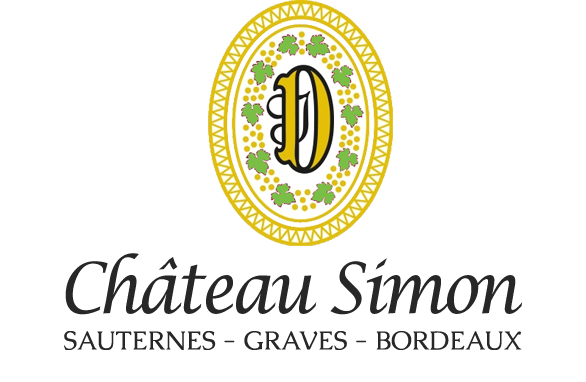
The Estate
Ideally positioned a few hundred meters from the village of Barsac in the Simon neighborhood, Château Simon has thrived here for 2 centuries.
Established in 1814, Château Simon began as a traditional French farm producing wine, fruits & vegetables. Over time, the estate has successfully prevailed as a strong wine producing specialist.
Today, the vineyard spans an impressive 33 hectares located on 3 major appellations: Sauternes, Graves, & Bordeaux. The vineyard produces wine varieties such as Sémillon, Sauvignon, Merlot, & Cabernet Sauvignon. Anne Laure Dufour-Bonnard & Pauline Dufour-Descamps remain loyal to their roots and honor their heritage by utilizing the invaluable knowledge and traditions of their ancestors alongside modern & innovative techniques.
Château Simon offers a large range of wines: Barsac-Sauternes, Graves Red, White & Sweet, Bordeaux Red, White & Rosé. For almost 3 decades, they have been an active member of the Vignerons Indépendant association.
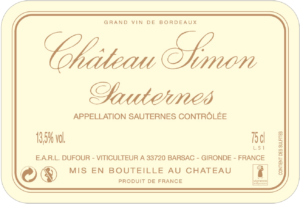
Château Simon Sauternes
Terroir: The vines are located in the Haut Plateau in the commune of Barsac on a unique clay and limestone soil resting on rocks with asterias (fossils).
Grape Varieties: 80% Sémillon, 18% Sauvignon Blanc, 2% Muscadelle
Viticulture: Sustainable viticulture techniques are widely used at the vineyard, where they implement modern bio-control solutions. Château Simon is proudly certified to High Environmental Value Level II.
Harvest: The grapes are handpicked with meticulous care, about 4-5 pickings. Only the overripe grapes are selected (botrytis cinereas).
Vinification: The botrytised grapes are delicately pressed for one night. After a cold soak, the must is fermented in thermo-regulated stainless steel tanks. The best pressings are selected and aged in oak barrels for 18 months.
Annual Production: 26,000 bottles
Winemaker Tasting Notes: “With a splendid gold robe, this wine has an intense nose of supple exotic fruits and citrus fruits. The attack is round and fruity with an ample evolution, rich and fresh. The finish is full of spicy notes and a delicate touch of freshness with a slight minty character.”
Food Pairings: This wine can be served as a brilliant aperitif with blue cheese. It is a perfect companion to white meats, spicy dishes, Asian cuisines and the traditional foie gras.
Château Siran

Overview
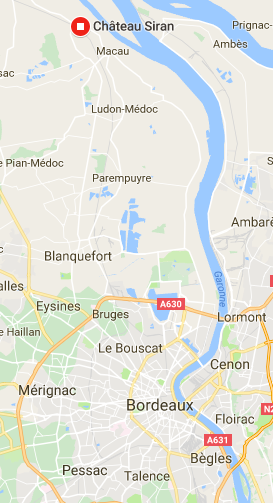
Located in the south of the Margaux appellation, on a plateau made up of gravelly outcrops, Château Siran possesses stunning terroir. Its 25 hectares in the Margaux appellation, 9 hectares in Bordeaux Supérieur and 2 hectares in Haut-Médoc are conducive to the production of delicate, fine and deliciously flavoursome wines. And it is to this end that Siran’s vineyard manager and cellar-master carry out their painstaking work throughout the seasons, bringing to the tables of wine enthusiasts, beginners and experts alike, the quintessence of our 36 hectare vineyard. Since 2013 the Château has re-opened its doors. Each visit is now an opportunity for us to help you get to know our heritage. From the terrace, with a panoramic view of the vineyard, to the heart of our new “Collections Cellar”, we are delighted to welcome you in a setting that combines the authentic with the modern.
History
On September 14th 1428, Guilhem de Siran swore a feudal oath in the church of Macau to the Abbot of Sainte-Croix de Bordeaux, to whom the parish was attached. At the end of the 17th century, the estate was already producing wine and was to enjoy a fine reputation in the 18th century, at a time when the Miailhe family settled in Bordeaux as wine brokers, a title granted to them by royal concession. It was in the 19th century, on the 14th January 1859 to be exact, that the Château was acquired by the actual family. Their ancestor, Léo Barbier, bought the estate for 100,000 francs from the Count and Countess de Toulouse-Lautrec, the grandparents of the famous painter, Henri de Toulouse-Lautrec. Ever since that time, generations of the same family have succeeded each other in a spirit of respect for the family wine-growing tradition.
Vineyard
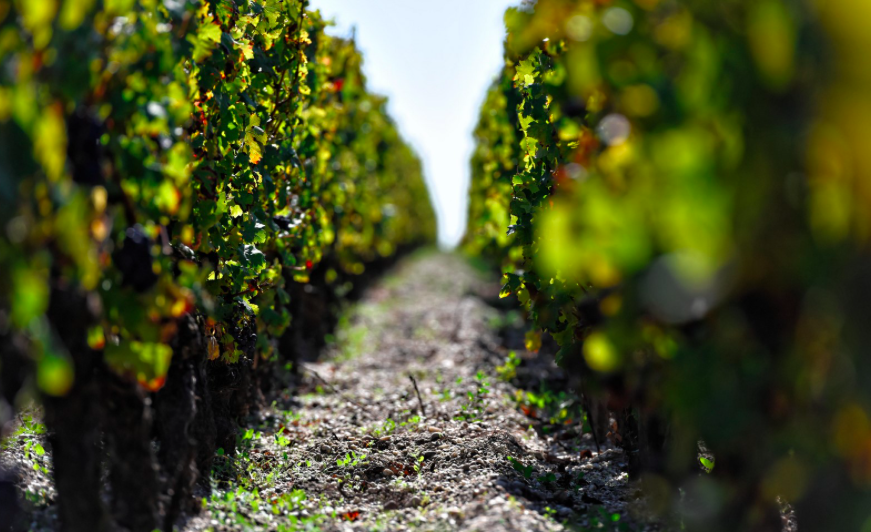 Some might say that luck was on the side of this vineyard, given its location a few miles north of Bordeaux on the famous Médoc peninsula and in the heart of the no less famous Margaux appellation. Its 25 hectares set in the Margaux appellation benefit from a terroir of amazing quality. Here, the soils are mainly made up of gravel and pebbles, which retain very little rainwater. The roots of the vines delve very deeply into the subsoil to find their nourishment, causing the vines to undergo the famous “water stress”, which is essential to the production of wines of truly great character.
Some might say that luck was on the side of this vineyard, given its location a few miles north of Bordeaux on the famous Médoc peninsula and in the heart of the no less famous Margaux appellation. Its 25 hectares set in the Margaux appellation benefit from a terroir of amazing quality. Here, the soils are mainly made up of gravel and pebbles, which retain very little rainwater. The roots of the vines delve very deeply into the subsoil to find their nourishment, causing the vines to undergo the famous “water stress”, which is essential to the production of wines of truly great character.
Grape Varieties
The vineyard also has its own particular grape composition:
- 46% Merlot
- 40% Cabernet Sauvignon
- 13% Petit Verdot
- 1% Cabernet Franc
Vinification and Aging
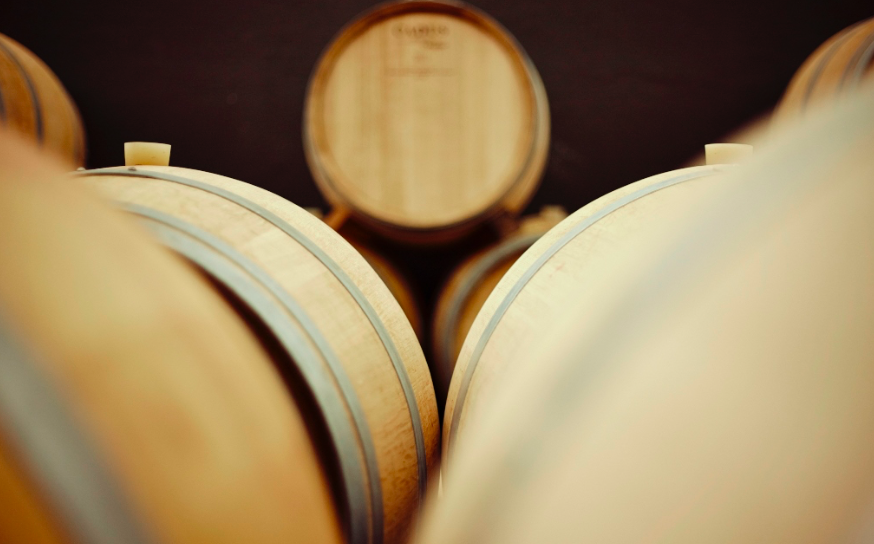 Nowadays, precision work begins in the vineyard itself -“plot by plot”. Only when the grapes have reached optimal ripeness is the decision taken to start the harvesting. The bunches are picked by hand in small crates and meticulously sorted both before and after the de-stemming process, so that only the finest grapes go into the vats.
Nowadays, precision work begins in the vineyard itself -“plot by plot”. Only when the grapes have reached optimal ripeness is the decision taken to start the harvesting. The bunches are picked by hand in small crates and meticulously sorted both before and after the de-stemming process, so that only the finest grapes go into the vats.
Though the wine-making remains traditional, the latest technology is carefully integrated to carry out a plot by plot vinification, to lavish even greater care on the grapes and to be able to extract the best from the fruit. This stage is followed by a period of ageing, which completes the wine-making process and enhances quality. This ageing is done in French oak barrels. Just the right degree of oak ageing is necessary for the balance of the wine’s tannins. Each generation at Siran has made every necessary effort to take this estate to the highest level.
The Wines
The grand vin is Château Siran, sourced from the Margaux vines with an average age of 31 years, and this goes into oak for 12-14 months with 35% new wood each vintage. The second wine S de Siran, also comes from the Margaux vines but these are younger, with a typical age of ten years. It too goes into oak for 12-14 months, but the proportion of new wood is naturally less, typically 15%. In addition, there are two other wines. First is the Bel Air de Siran, once produced from a few hectares of vines (70% Cabernet Sauvignon and 30% Merlot situated between Siran and Dauzac but entitled only to the Haut-Médoc appellation. Another is the Saint-Jacques de Siran, a Bordeaux Supérieur, which is sourced from 9.8 hectares entitled only to the Bordeaux Bordeaux Supérieur appellation. This vineyard is still characterised by sandy gravel, but with more clay, and the vines are 26 years old. It is fermented in steel, like its grander counterparts, and sees out 12 months in oak, including 15% new wood.

Chateau Siran Margaux
Winemaker Notes: “Produced from soils made up of a deep layer of gravel, the wines of Siran are typical of the great Margaux growths. Both powerful and delicate, they express the perfect balance between tannin, fruit and acidity. They are long-aging wines, which over time develop sweetness on the palate, giving a characteristic silky and velvety mouth-feel. Made from a subtle blend of Merlot, Cabernet Sauvignon and Petit Verdot, Château Siran generally expresses finesse, femininity and silkiness rather than the raw power and virility of some Médoc wines. The high percentage of Petit Verdot, which can be as much as 15% of the final blend in some years, brings a spicy finish which enhances the unique character of the wines of Château Siran. Château Siran displays charm when young but is also a wine of very long aging potential. Wine enthusiasts particularly appreciate the complexity of its aromas that it develops over time.”
Proprietor: Famille Miailhe SCEA Château Siran
Managing Directors: Edouard & Brigitte Miailhe
AOC Margaux Area: 25 hectares
Soil: Deep gravel
Grape Varietals: Merlot, Cabernet Sauvignon, Petit Verdot, Cabernet Franc
Average Age of the Vines: 31 years
Harvest: Hand picking into 60 liter crates
Vinification: Thermo-regulated stainless steel vats
Aging: 12 months in oak barrels, 35% new barrels
Annual Production: 90-95,000 bottles
2014 Reviews: “…fresh nose with mint, fennel and sage infusing the black fruit…The palate is medium-bodied with fine grain tannin. There is a pleasant symmetry here, understated and linear, but nicely focused with a tensile, structured finish that lingers nicely in the mouth.”-92pts, Vinous
2012 Reviews: “…a very composed and delineated bouquet with scents of red plum, raspberry, mineral, cedar and a touch of graphite. The palate is medium-bodied with fine, gently grippy tannin, and graphite-tinged black fruit that turns spicier towards the finish, which displays commendable substance and persistence…”-90pts, Wine Advocate

S de Siran
Winemaker Notes: “S de Siran is the Second Wine of Château Siran, and is also from the Margaux appellation. It is sourced from the vineyard’s young plots and from a selection of the First Wine that varies according to the vintage. The average age of the vines is between 5 and 15 years and, depending on the vintage, the volume of S de Siran is 30 to 40% of the total volume of production of the estate’s Margaux appellation wine. The grape composition is a blend of Merlot, Cabernet Sauvignon and Cabernet Franc. This wine, which we look on as the little brother of the First Wine, is made with the same care and attention that the First Wine receives. It displays both charm and complexity and generally should be enjoyed within 5 to 7 years of age. Ideal drunk young and popular with numerous restaurants, it pairs well with white and red meats as well as with pasta dishes, pies and soufflés.”
Proprietor: Famille Miailhe SCEA Château Siran
Managing Directors: Edouard & Brigitte Miailhe
AOC Margaux Area: 25 hectares
Soil: Deep gravel
Grape Varietals: Merlot, Cabernet Sauvignon, Petit Verdot, Cabernet Franc
Average Age of the Vines: 10 years
Harvest: Hand picking into 60 liter crates
Vinification: Thermo-regulated stainless steel vats
Aging: 12 months in oak barrels, 15% new barrels
Annual Production: 30-35,000 bottles

Saint-Jacques de Siran
AOC: Bordeaux Supérieur
Production Area: 9 hectares
Location: Sourced from plots belonging to the estate located on the border of the Margaux appellation.
Soil: Over the centuries, the alluvial soils coming from the Garonne River have covered over the gravel to make a soil which is now made up of clay. This complex terroir produces rich and well-structured wines.
Grape Varieties: Merlot, Cabernet Sauvignon, and Cabernet Franc, the proportions of which vary according to the vintages.
Average Age of the Vines: 26 years old
Annual Production: 25-30,000 bottles
Harvest: Hand picking in 60 liter crates and harvesting machine
Vinification: Traditional, in temperature-controlled vats. Maceration lasts 25 days.
Aging: In barrels for 10-12 months and tank with stave.
Serving Suggestion: This wine is best enjoyed within 4 to 5 years of its production. Its softness and complexity make Saint Jacques de Siran a popular choice among wine lovers.

Bel Air de Siran Haut-Médoc
Technical Team: Jean-Luc Chevalier and Marjolaine Defrance
Managing Team: Edouard Miailhe and Brigitte Miailhe
Overview: This vineyard has belonged to the Miailhe family for six generations. Carefully vinified by Siran’s team who mainly grow Merlot and Cabernet Sauvignon to create a fine and elegant wine with a long finish.
Location: Produced from a few hectares of vines situated between Siran and Dauzac but entitled only to the Haut-Médoc appellation.
Appellation: Haut-Médoc
Production Area: 0.5 hectares
Soil: Terrace of deep sandy gravel soil.
Grape Varieties: Merlot 100%
Average Age of the Vines: 25 years old
Plant Density: 9,000 feet/hectare
Viticulture: Sustainable viticulture with chemical treatments except for the compulsory treatment for “flavescence dorée”. Soil ploughing; organic fertilization; ventilation of vegetation: manual trimming, leaf stripping and cluster thinning; voluntary crop limitation.
Pruning Method: Guyot double Bordelais with disbudding.
Harvest: Manual harvest in small crates with manual sorting on table. Intra-plot selection.
Vinification: Fermentation in stainless steel vats. Pumping over and releasing depending on the batches. Vatting period of 18 to 24 days.
Aging: 12 months with French new oak wood.
Château Smith Haut Lafitte

The Estate
In the 14th century, Verrier Du Bosq signed the first recorded deeds for a few vine rows. George Smith, a Scottish wine merchant, acquired the property in the mid-18th century and named it after himself.
Lodi Martin Duffour-Dubergier, Mayor of Bordeaux and signer of the official 1855 classification, acquired the estate in 1842 and elevated it to Grand Cru Exceptionnel status. In the early 20th century, the négociant firm Eschenauer, headed by the famous “Uncle Louis” Eschenauer, sold Smith Haut Lafitte wines and ended up buying the château in 1958.
In 1990, Daniel and Florence Cathiard fell in love with Château Smith Haut Lafitte, which they acquired with the firm intention of perpetuating its tradition of excellence. “Our philosophy can be summed up in one sentence: to do everything possible to make each vintage of red and white wine worthy of our magnificent terroir.”
After three years spent renovating the estate, the Cathiards came to live there, in the 18th century chartreuse dating from George Smith’s time, in order to devote themselves to overseeing winegrowing, with the help of a talented and motivated team.

Le Petit Haut Lafitte Pessac-Léognan Rouge
Average Yield: 36 hl/ha
Grape Varieties: Cabernet Sauvignon, Merlot
Average Age of the Vines: 11 years old
Viticulture: Selection Massale – Grafted on their mother rootsock grown at the estate. The vines are tended using organic & biodynamic methods.
Vinification: Grapes are sorted twice, before and after destemming, and are not pressed before undergoing fermentation in vats. The grapes used in the second wine blends, namely Le Petit Haut Lafitte and Les Hauts de Smith, are sent to the Chai Furtif (“Stealth Winery”), which takes its name from its location, almost hidden amongst nature. Here, they implement the circular economy, a local and eco-friendly economic model. Designed to limit its environmental impact, the winery runs on positive energy, particularly thanks to low consumption and the production of solar energy, rainwater recovery, a ground-coupled heat exchanger to cool the barrel cellars, etc. In 2014, they also installed the world’s first system that recycles the CO2 produced during fermentation. Tannins and color are extracted by punching down and/or pumping over.
Aging: 14 months in barrels (20% new barrels) produced in the in-house cooperage.
Winemaker Tasting Notes: “Le Petit Smith Haut Lafitte red is extremely fine with silky tannins and beautiful aromas and flavours of Cabernet Sauvignon. Medium-bodied, with notes of blackcurrant, liquorice, and dark chocolate. A great finesse and a good structure with a lot of aging potential.”

Le Petit Haut Lafitte Pessac-Léognan Blanc
Grape Varieties: 80% Sauvignon Blanc, 20% Semillon
Appellation: Pessac-Léognan
Average Age of the Vines: 11 years old
Average Yield: 32 hl/ha, before production was divided into three wines: Château Smith Haut Lafitte, Les Hautsde Smith, and Le Petit Haut Lafitte.
Fermentation: The grapes are hand-picked into small crates and pressed in an oxygen-free environment using inert gas to retain the grapes’ aromatic potential, followed by fermentation in French oak barrels (50% new oak) and cold settling.
Aging: 12 months on the lees in barrels (50% new oak) from the on-site cooperage.
Tasting Notes: Bright pale yellow color, citrus and white flowers on the nose with a distinctive scent of lime, grapefruit with a touch of pears. The palate is medium to full-body, fresh and soft creamy texture of honeydew and hot- stone character. Balanced, vivid and tight, the vibrant citrus flavors finishes with a mineral touch. The great texture of this wine will delight your palate and pair very well with your entrance, fish or cheeses.
Château Sociando-Mallet
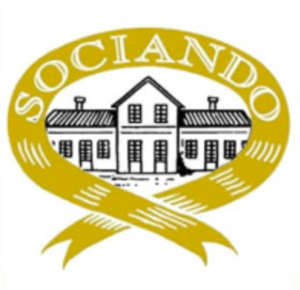
Overview
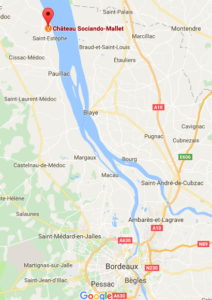 Jean Gautreau discovered Sociando-Mallet in the village of Saint-Seurin-de-Cadourne in 1969 when looking for a wine estate to buy on behalf of a Belgian client. It was love at first sight, despite the fact that the property was in a sorry state. However, the terroir was excellent and the domain afforded a magnificent view overlooking the Gironde Estuary. Jean Gautreau immediately decided to acquire it for himself for 250,000 French francs.
Jean Gautreau discovered Sociando-Mallet in the village of Saint-Seurin-de-Cadourne in 1969 when looking for a wine estate to buy on behalf of a Belgian client. It was love at first sight, despite the fact that the property was in a sorry state. However, the terroir was excellent and the domain afforded a magnificent view overlooking the Gironde Estuary. Jean Gautreau immediately decided to acquire it for himself for 250,000 French francs.
There were only 5 hectares of vines at the time. Jean Gautreau expanded the vineyard year after year by buying vines from his neighbours. Seeking the best possible quality, he also renovated the estate’s buildings, built a barrel cellar, and gradually improved the choice of grape varieties, matching the appropriate ones to each vineyard plot.
Today, the property is comprised of 83 hectares producing nearly 450,000 bottles a year of Château Sociando-Mallet and the second wine, Demoiselle de Sociando-Mallet. Jean Gautreau sold his négociant business in 2000 and now focuses entirely on managing his wine estate.
Château Sociando-Mallet is in the commune of Saint-Seurin-de-Cadourne, ten kilometres north of Pauillac, in the Haut-Médoc appellation. A document dating from March 1633 refers to land here belonging to an aristocrat of Basque origin named Sociondo. A member of his family was Bishop of Bayonne. Another document, from 1750 mentions vines belonging to Demoiselle Anne de Sossiondo. Due to various misspellings over the years, “Sossiondo” became “Sociando”.
The Terroir
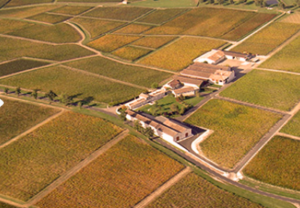 Sociando-Mallet has throned on the Butte de Baleyron, one of the finest gravelly terroirs in the Médoc, since the 17th century. Situated in the commune of Saint-Seurin-de-Cadourne, north of Pauillac, the vineyard overlooks the Gironde estuary on a bend in the river.
Sociando-Mallet has throned on the Butte de Baleyron, one of the finest gravelly terroirs in the Médoc, since the 17th century. Situated in the commune of Saint-Seurin-de-Cadourne, north of Pauillac, the vineyard overlooks the Gironde estuary on a bend in the river.
Sociando-Mallet’s terroir consists of Günz gravel over a deep layer of clay-limestone soil. This terroir perfectly regulates water supply and enables Cabernet Sauvignon to ripen extremely well and Merlot to acquire depth and complexity. This terroir is Sociando’s soul. It provides the wine with complex structure, freshness, and elegance.
Primarily located east of the village of Saint-Seurin, the property stretches over a total of 120 hectares, of which 83 are under vine. The vines grow on the superb Baleyron gravelly hillock around the house and winery buildings. Sun exposure is optimum and breezes off the estuary keep the vines well aired and healthy. The huge mass of water in the estuary and nearby ocean accounts for a temperate microclimate without wild swings in temperature. Grape varieties consist of 42% Cabernet Sauvignon, 54% Merlot, and 4% Cabernet Franc. The vines are an average 35 years old. The average vine density is 8,333 vines per hectare. This corresponds to 1 metre between vine rows and a distance of 1.2 metres between plants within a row. This high density increases the surface of the leaf canopy and creates a competition between vines, conducive to the production of grapes with a high content of tannin, sugar, colour and aromas.
The Winemaking Process
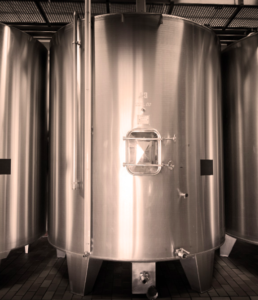 Sociando Mallet is vinified traditionally. Only native yeast and bacteria naturally present on the grapes and at the estate are used. Sociando-Mallet has stainless steel and concrete vats, both of which are temperature-controlled. Once the wine is put into vat, the crushed grapes start to ferment thanks to the presence of yeast. The skins and pips float to the surface and form a cap above the must (fermenting grape juice). The vats are pumped over daily to extract colouring matter and aromas from this cap. Pumping over consists in spraying the cap with must taken from the bottom of the vat.
Sociando Mallet is vinified traditionally. Only native yeast and bacteria naturally present on the grapes and at the estate are used. Sociando-Mallet has stainless steel and concrete vats, both of which are temperature-controlled. Once the wine is put into vat, the crushed grapes start to ferment thanks to the presence of yeast. The skins and pips float to the surface and form a cap above the must (fermenting grape juice). The vats are pumped over daily to extract colouring matter and aromas from this cap. Pumping over consists in spraying the cap with must taken from the bottom of the vat.
The wine stays on the skins for an average of 25-30 days depending on the vat and the vintage.
Then comes the running off when the free run wine is separated from the pomace (skins and pips). The press wine is produced by putting the pomace through a winepress. These wines are then put into vat for malolactic fermentation. This secondary fermentation occurs spontaneously due to friendly bacteria naturally present in the wine, which transform malic acid into lactic acid. This therefore makes the wine smoother and more balanced.
After this malolactic fermentation, lots chosen to become Sociando-Mallet are put into 100% new French oak barrels and aged for approximately 12 months. Only a quarter of the wine destined to be sold as Demoiselle de Sociando-Mallet is aged in new oak. The remainder is aged in vats until the blending to preserve this wine’s suppleness and fruitiness.
Aging
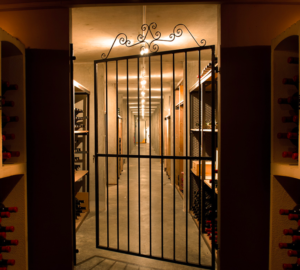 For the first 3 or 4 months, the barrels are kept with a glass bung on top. As the new oak absorbs a lot of wine at the beginning of ageing, the amount that evaporates is replaced twice a week in a process called topping up. After this period, we close the barrels with a wooden bung and we store it “bung on the side» to limit the evaporation and protect the wine from oxidation.
For the first 3 or 4 months, the barrels are kept with a glass bung on top. As the new oak absorbs a lot of wine at the beginning of ageing, the amount that evaporates is replaced twice a week in a process called topping up. After this period, we close the barrels with a wooden bung and we store it “bung on the side» to limit the evaporation and protect the wine from oxidation.
The wine is racked twice a year during ageing to separate it from the lees at the bottom of the barrel or vat. For the barrels, this operation is done the traditional way using gravity flow via the esquive, a small bunghole. At Sociando-Mallet, the esquive bungs are wrapped in dried reeds (called matrasse locally) to make the seal airtight. This plant, Typha latifolia (or broadleaf cattail in English), grows in marshland and ditches along the banks of the Gironde. Cellar workers pick the leaves twice a year.
The wine is not fined and is only lightly filtered before bottling to retain all its intrinsic qualities and preserve its outstanding ageing potential.
Cellar aging
La Demoiselle is aged for 15 months and Sociando-Mallet for 18 months before bottling at the château. Special attention is paid to the quality of the corks, which are purchased according to strict specifications. They must be good enough to ensure perfect ageing for long periods, sometimes more than 40 years.

Château Sociando-Mallet Haut-Médoc
Grape Varieties: 54% Merlot, 42% Cabernet Sauvignon, and 4% Cabernet Franc
Aging: 100% in new French oak barrels for 12 month
Food Pairings: Beef & Venison
Tasting Notes: Château Sociando-Mallet produces full-bodied wines with a deep, dark color. Their complex bouquet is usually dominated by black fruit aromas with a touch of minerality and well-integrated, elegant oak. Often somewhat “virile” when young, the wines gain in balance and complexity with age. They are fresh, straightforward, and have a wonderful length.
Cellaring Potential: Château Sociando-Mallet has always been a wine with great aging potential. A wine to be enjoyed even after 30 years in great vintages.
2008 Reviews: “…the full-bodied 2008 offers abundant notes of plums, blueberries and black raspberries interwoven with hints of white flowers, damp earth and background oak. This impressively endowed, muscular effort will benefit from 2-4 years of cellaring and should keep for two decades.” -90pts, Wine Advocate

La Demoiselle de Sociando-Mallet Haut-Médoc
Overview: The Demoiselle de Sociando-Mallet is produced from the younger vines of the property and the plots whose soil is more favorable to the production of very good Merlot. These vines receive the same care and are tended in the same way as the rest of the vineyard throughout the year. The “demoiselle” is a sort of dragonfly found in the Médoc. Like the dragonfly, this wine of the same name is light and elegant.
Production Area: 20 hectares
Grape Varieties: 54% Merlot, 42% Cabernet Sauvignon, and 4% Cabernet Franc
Average Age of the Vines: 35 years old
Aging: The aging of the Demoiselle de Sociando-Mallet is carried out mainly in vats, to preserve the freshness and fruitiness of the Merlot.
Serving Suggestions: This easy-drinking wine can be enjoyed young. It is an ideal match for grilled meat and fish or shellfish dishes.
Château Soutard
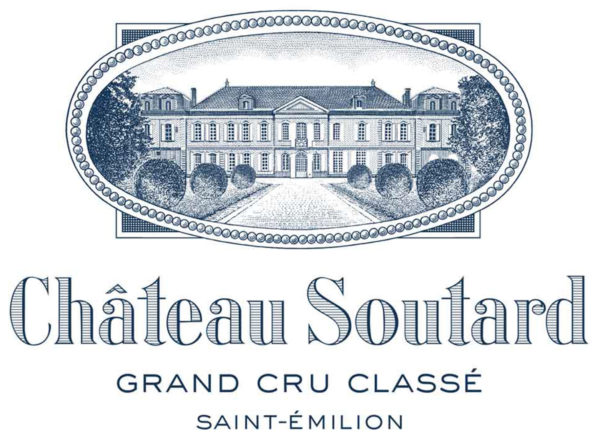
The Estate
The origins of Château Soutard are ancient, with the first traces dating back to 1513. The estate was acquired in 2006 by the insurance group AG2R La Mondiale which has continued to undertake major renovations. In 2012, the purchase of the Cru Classé Cadet Piola brings the vineyard to 30 hectares situated on the clay and limestone plateau of Saint-Émilion. The cellar is managed by Véronique Corporandy who is advised by Michel Rolland. The Second Wine, produced from the younger vines of the chateau, is a Saint-Émilion full of charm that can be served and appreciated while young.

Château Soutard Saint-Émilion Grand Cru Classé
General Manager: Bertrand de Villaines
Production Area: 30 hectares
Terroir: 70% clay-limestone plateau; 17% clay-rich slopes; 13% of vines on sandy soils
Grape Varieties (since 2012): 63% Merlot, 28% Cabernet Franc, 7% Cabernet Sauvignon, 2% Malbec
Average Age of the Vines: 35 years old
Plant Density: 6,500 vines per hectare
Viticulture: Traditional farming methods in order to respect the soils, the vineyard, and wild life. Early shedding and disbudding. Adapted green bunches of grapes removal process. Early thinning out and leaf removal. Green harvest.
Harvest: By hand; grapes are sorted in the vineyard and in the vat room.
Aging: 18 months aging in French oak barrels coming from 8 different cooperages.
2010 Reviews: “This sports very flashy raspberry ganache, pastis-soaked plum and steeped currant fruit, but stays vibrant, thanks to a backdrop of mouthwatering wood spice and a racy graphite spine that really holds the finish tightly. Very solid grip. Best from 2015 through 2025. 2,916 cases made.” – 92pts, Wine Spectator

Les Jardins de Soutard
Production Area: 30 hectares
Terroir: 70% clay-limestone plateau, 17% clayey hillside, 13% sandy coastline
Grape Varieties: 63% Merlot, 28% Cabernet Franc, 7% Cabernet Sauvignon, 2% Malbec (percentages vary depending on the vintage)
Average Age of the Vines: 35 years old
Plantation Density: 6,500 plants/hectare
Harvest: The cultivation methods are traditional, reasoned and ensure the greatest respect for the soil, the vine, and the terroir. The harvest is manual with sorting done in the vineyard and the winery.
Aging: In French oak barrels, from 8 different cooperages, lasting an average of 18 months.
Alcohol: 13.5%
Tasting Notes: Deep ruby color. On the nose, a seductive and full-bodied bouquet of ripe red fruit and spices. On the palate, there is roundness, power, and a touch of freshness on the finish.
Food Pairings: With grilled steak, wild game, etc.
Cellaring Potential: 5-10 years

Petit Soutard Saint-Émilion
Overview: Petit Soutard is the second wine of the estate and is produced from a selection of Veronique Corporandy, Technical Director of the estate. It is vinified by the team of Château Soutard and Château Larmande, Grands Crus Classés de Saint-Emilion.
Appellation: Saint-Emilion
Production Area: 30 hectares
Grape Varieties: 80% Merlot, 20% Cabernet Franc
Aging: 5 months in oak barrels
Tasting Notes: Rich and lively black cherry, blackberry, and raspberry notes. Silky texture.
Serving Temperature: Serve between 16 and 18°C



